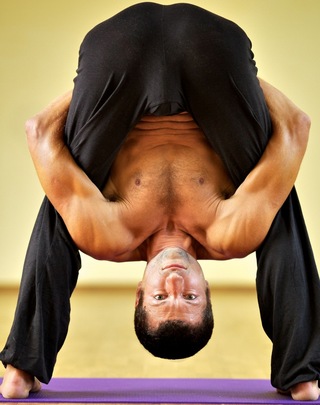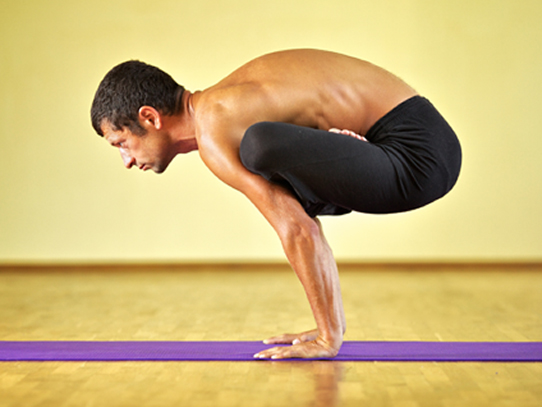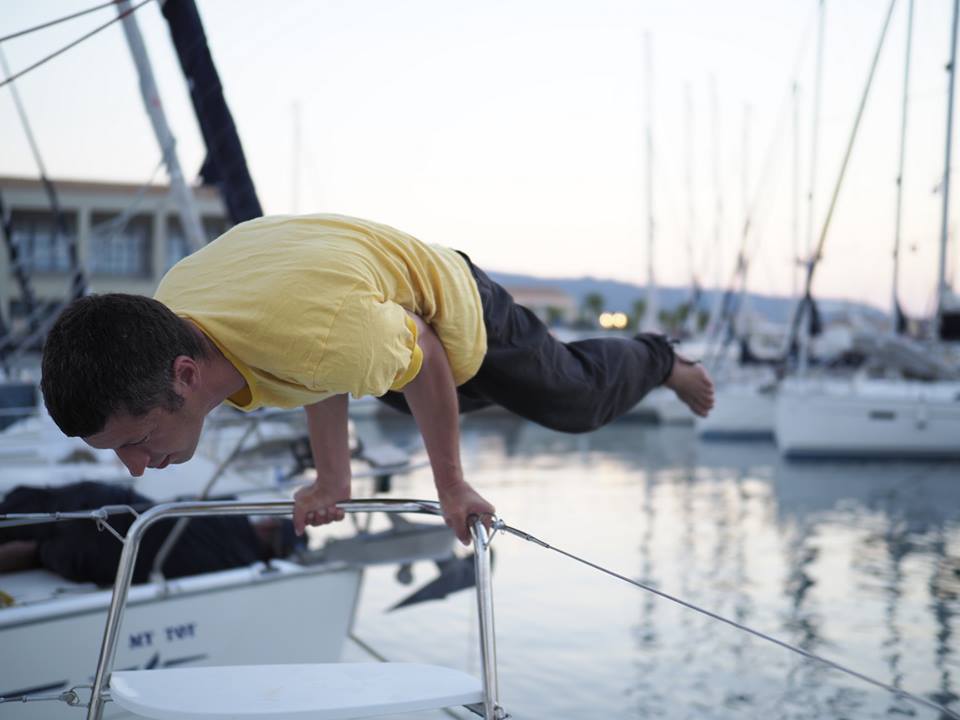Interview with Oleg Diachenko, Kiev hatha yoga teacher and developer of Spine and joints stabilisation training system

Oleg Diachenko, a Kyiv hatha yoga teacher, Redcord instructor and the founder of training system for Stabilisation of spine and joints, shared with TopYogis some insights on why 15-minute yoga is the most effective workout, how to practice yoga when one is afraid, what happens when one develops a habit of keeping attention inside one’s body, and many other things.
TopYogis: Oleg, what are your goals in yoga?
Oleg Diachenko: It’s a good question. For me, yoga is, perhaps, interaction with people. I cannot reply right away because I don’t have special goals on my own. New goals mean new karma :)
TopYogis: How did you start your path in yoga?
Oleg Diachenko: Even when I was a child, I liked to do abdominal exercises - intuitively, I knew nothing about yoga then. Then, at school, I practiced some martial arts. One day my teacher advised me to start doing yoga. I bought a book of Andrei Sidersky, and I liked it a lot. Then I bought his video and there was his number. I called it and that’s how I became a student of Andrey Sidersky.
TopYogis: How long have you practiced with him?
Oleg Diachenko: All the way until he stopped teaching. He took a long-time time off to work on his Yoga23 training system. When he presented this new system, all his old students were there. But I did not like Yoga23 too much. For me, it is quite monotonous, tough system.
TopYogis: So, you developed the practice in your own style?
Oleg Diachenko: That happened later. At the beginning, I taught exactly how Andrey Sidersky taught us.
TopYogis: Tell us about your system for Stabilisation of spine and joints.
Oleg Diachenko: It was developed on the basis of my experience with Andrey Sidersky, Anatoliy Zenchenko, workshops with Shandor Remete and Bryan Kest.
Also, the friends that were practicing with me, asked me to participate in Red Cord project. I worked with them and took special training and Redcord courses. But the equipment for Redcord is quite expensive, not every person can afford this practice. Therefore I decided to develop a system that would implement the same principles and be affordable to an average person. It developed in a training regimen that helps eradicate back pain, and lumbar pains particularly. The component of treating lumbar pain is elaborated quite well as I had some injuries in my lumbar and I worked hard to figure out the best approach to address it. And now I can tell that this system really helps.
TopYogis: So you tested this system on yourself?
Oleg Diachenko: On myself and on many other people who were visiting my classes. I adapted exercises from yoga to engage necessary muscles for back rehabilitation.
TopYogis: And what exactly have you adapted?
Oleg Diachenko: For example, Sidersky had an exercise where you lift your legs lying on your side. I adapted this exercise so that you had to balance in this position. The basis for my system is work with balance. It’s all the theory I took from Redcord. The methodology lies in the distinction between two muscle groups: muscles of movement and stabilizing muscles. Stabilizers support the position of the spine while muscles of movement bend it, twist it and do other things that we need. If stabilizing muscles do not work, the muscles of movement take on the load. But if both muscle groups work properly, a person is strong not because he increased the muscle size, but because he properly distributed the load between the muscles.
TopYogis: So your system works with the deep muscles along the spine such as erector spinae etc.?
Oleg Diachenko: Yes, and the basis of this work is the balance. Because, if we just do exercise to “strengthen” the back, the stabilizers won’t develop.
TopYogis: Because “strengthening” the back develops muscles of movement, such as trapezius, latissimus, etc…
Oleg Diachenko: Yes, and you can develop these muscles, but they will not support your back properly, as they get tired quickly.
TopYogis: I have an impression that yoga, in general, engages these stabilizing muscles more than other types of activities like running, etc.
 Oleg Diachenko: Certainly. That’s why yoga will remain a popular health enhancing system for a long time. Because in other types of physical activity, how long can a person do fitness exercises? Until one is 40 or 50 years old maybe. And then the energetic credit given by the parents will expire. One will need to save energy. But if we engage deep stabilizing muscles and develop them, you don’t spend a lot of energy. You can sit in meditation for hours and days without any problem or discomfort.
Oleg Diachenko: Certainly. That’s why yoga will remain a popular health enhancing system for a long time. Because in other types of physical activity, how long can a person do fitness exercises? Until one is 40 or 50 years old maybe. And then the energetic credit given by the parents will expire. One will need to save energy. But if we engage deep stabilizing muscles and develop them, you don’t spend a lot of energy. You can sit in meditation for hours and days without any problem or discomfort.
TopYogis: What is your attitude to a headstand? Do you teach headstand in your classes?
Oleg Diachenko: No, I do not teach headstand in my classes, because many people have neck problems. I would rather give handstand or forearm stand. Sidersky also used to teach like that. If a person can do a handstand, they can do a headstand too. But if one tries to do a headstand with undeveloped arms and shoulders, one will get nothing but problems.
TopYogis: Quite often teachers give headstand to their students in the very first class.
Oleg Diachenko: That’s because nowadays, there is a belief that one has to impress people to engage them. One needs to show something so that the students would say: “Wow! I can do a headstand!” People pursue new emotions and impressions. And it’s not bad, but they develop sidewise, not depth-wise. That’s why these things like headstand are popular, you can perform one in front of your friends and impress them.
The basis for my Spine and joints stabilisation system is work with balance. It’s all the theory I took from Redcord. The methodology lies in the distinction between two muscle groups: muscles of movement and stabilizing muscles. Stabilizers support the position of the spine while muscles of movement bend it, twist it and do other things that we need. If stabilizing muscles do not work, the muscles of movement take on the load. But if both muscle groups work properly, a person is strong not because he increased the muscle size, but because he properly distributed the load between the muscles.
TopYogis: Tell me, do you believe that a form of asana - its beauty and level of difficulty - can indicate one’s progress in yoga? Can we say that flexible people, for instance, are “better yogis” than non-flexible?
Oleg Diachenko: No. As Andrey Sidersky said, and I completely support it, the best yogis are people that struggle with the postures. Because, what is the purpose of yoga? To stop inner dialogue. And when is it stopped? When we’re doing something difficult. Difficult for you. If a headstand for me is easy, I will not stop my inner dialogue. But if a person is doing it for the first time, they will be absorbed in it, at least, they will be concentrated.
TopYogis: If a person has 15 minutes a day to practice yoga, what is the main thing you would recommend to do?
Oleg Diachenko: To do what one wants to. And this is the main thing. When a cat is waking up, what does he do? What he feels like.
TopYogis: But what if one is lazy? And does not want to do anything?
Oleg Diachenko: Then Shavasana every day (laughing).
TopYogis: There is a theory that we are lazy by nature and we have a tendency towards inertia. And most often we do what we already can do well.
Oleg Diachenko: No, I don’t agree. If we want to show off, we do what we already can do well. But if nobody is watching us, we’re trying to learn something new to be able to show off later (laughs).
The best yogis are people that struggle with the postures. Because, what is the purpose of yoga? To stop inner dialogue. And when is it stopped? When we’re doing something difficult.
TopYogis: Some think that one has to push oneself a bit to come out of comfort zone.
 Oleg Diachenko: Well, at least you need to push yourself to stand on your yoga mat, and then maybe you will get inspired to practice. In this regard, a 15-minute practice is the most effective one. Not because of 15 minutes, but because you need to practice when you feel like it. If you cannot force yourself to practice, you need to practice when you want it. But the problem is, very often when you have this desire to practice, you need to do other things - wash dishes, do some chores. And when you finish all these things, the desire to practice is gone. Therefore if you feel the desire to practice, act on it right away. In this way, you will get a better effect without forcing yourself too much.
Oleg Diachenko: Well, at least you need to push yourself to stand on your yoga mat, and then maybe you will get inspired to practice. In this regard, a 15-minute practice is the most effective one. Not because of 15 minutes, but because you need to practice when you feel like it. If you cannot force yourself to practice, you need to practice when you want it. But the problem is, very often when you have this desire to practice, you need to do other things - wash dishes, do some chores. And when you finish all these things, the desire to practice is gone. Therefore if you feel the desire to practice, act on it right away. In this way, you will get a better effect without forcing yourself too much.
TopYogis: We liked your class. There is a lot of intensive yoga in Kyiv, but some classes are quite injury-prone (to my view).
Oleg Diachenko: Yes, because safety and injury avoidance are not one of the priorities. Because nowadays, mainly young people are practicing and teaching yoga. And injuries in young age heal quickly.
TopYogis: I have noticed that many teachers trust their tradition so much that they literally force people to do some things like headstands, being certain that they will not hurt. I am not entirely certain that 10-minute headstand, even with the best technique, will not hurt me.
Oleg Diachenko: If a person is reluctant or afraid to do something and one is forcing them, it’s already not safe. There is no harmony in such practice.
TopYogis: And sometimes the person is not afraid, but knows by her own experience that certain exercise is not good for them. For example, one knows that after standing in halasana for a few minutes they will have 2 days of a headache.
Oleg Diachenko: This is an experience, and you can work with it. Yoga is the expansion of your capabilities. When a person comes to yoga for the first time, they do not know their capabilities, the capabilities of their bodies. First, the person finds out their capabilities. And then, slowly, working on the edge of pain and fear, they expand these capabilities. If the person is afraid to do something, if they have a negative experience, they need to understand that they do not have to do anything to the full degree, they only need to approach their limit and stay there, not crossing it. For example, if I am afraid to stand on my head, I can put my legs on the chair. If I get used to it and don’t feel fear in this position, I can lift one leg, then the other leg, and so on. The same should be done in regards to the pain. If you feel pain — roll back, to a more simple position, and work there, very slowly expanding your limits.
But one can do this only when one has the attention inside one’s body. When your attention is somewhere else, you will not be able to expand your limits. But if you develop a habit of keeping your attention inside your body, you will change the way you react to things. For example, when one steps on your foot, first you will react as usual. And then you will think; “Why am I reacting this way? Nothing special has happened”. And gradually, as you practice keeping attention inside your body, the time between automatic reaction and understanding that nothing special has happened, will shorten. Until there is no gap, and when somebody steps on your foot, you can choose how to act. This what yoga actually is.
Yoga is the expansion of your capabilities. When a person comes to yoga for the first time, they do not know their capabilities, the capabilities of their bodies. First, the person finds out their capabilities. And then, slowly, working on the edge of pain and fear, they expand these capabilities. But one can do this only when one has the attention inside one’s body.
If you have practiced with Oleg Diachenko, please share your experience by leaving a review on his personal page. On this page, you can also contact him and check where he is currently teaching.
Find hatha yoga instructors around the world.
Find yoga teachers in Kiev (all styles)
If you're a yoga teacher, create your profile page on TopYogis. Here's what it can give you.
